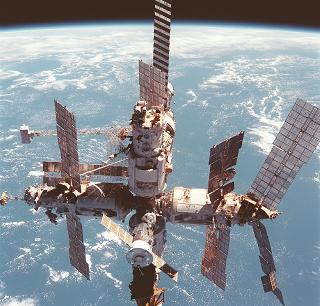Space debris mitigation measures address issues in two major areas: protection from space debris and reduction of the space debris population growth.
Protection methods vary depending on the size of the space debris. Space debris fragments smaller than 0.1 mm in diameter do not have enough energy to penetrate protection panels. Even spacecraft thermal blankets and structural panels can offer protection from such small kinetic impactors.
However, larger debris fragments pose a more serious threat and there are few active measures that can be adopted to minimize the possibility or the consequences of impacts.
First, avoiding space debris is the method that always proves successful, so flying at altitudes and inclinations where space debris density is low should always be considered. Second, orienting sensitive surfaces away from or mounting a bumper on the leading edge can offer more protection for the spacecraft. Multilayered bumpers cause the fragmentation of the space debris and also prevent ejected material from dispersing from the point of impact. Bumpers add mass and volume to the spacecraft and this is why few space missions can exercise this option.
A promising new method for protection from orbital debris impact is shielding with metallic foams. Extensive research and experimental impact campaigns have proven that metallic open-cell foams provide improved protection against hypervelocity impacts with almost no ejecta generated at impact, while offering comparable mechanical and thermal performance to honeycomb structures, which are currently used for shielding. The fact that no ejecta are generated is of great importance, as fragments generated at impact can add to the already existing debris population in Earth orbit.
At this point, it appears that the best protection method is avoiding the creation of space debris.
The long-term projections of the space debris environment generated by models like LEGEND or DELTA have proven that only active methods can maintain a stable environment of artificial objects in Earth orbit. It is quite obvious that unchanged operational practices or even an immediate stop to launch and release activities will not prevent the collisions between already existing space hardware. Scenarios like the one proposed by NASA scientist Donald J. Kessler in 1978 are very likely to occur. In the scenario proposed by Kessler, which is also known as the Kessler Syndrome, space exploration and the use of satellites in proximity of Earth will become unfeasible due to an exponential growth of the debris population caused by collisional cascading. The exponential growth is due to the fact that the material ejected during a hypervelocity impact becomes space debris itself. Laboratory experiments have shown that as a result of such an impact, 1 kg of aluminum can form several hundred thousand 1 mm sized particles.
Failure to address the potential uncontrollable growth of the space debris population will lead to major restrictions on the ability to exploit space. There is a debate in the scientific community over whether or not critical density has already been reached in certain orbital regions and if we are beyond the point where we can address the growth of the debris population.
There are various classifications of the space debris mitigation methods. For example, two broad categories might include, on one hand, measures that restrict the generation of space debris in the near future, such as limiting the production of mission-related objects and the avoidance of breakups, and, on the other hand, measures that restrict their generation for the long term, which include post-mission disposal methods and active measures to remove space debris from protected regions.
There are three major areas that could allow space faring nations to maintain a stable debris environment: space traffic management, control the creation of space debris, and active space debris environment remediation.










 Subscribe to our RSS feed
Subscribe to our RSS feed











There are no comments.
Add A Comment